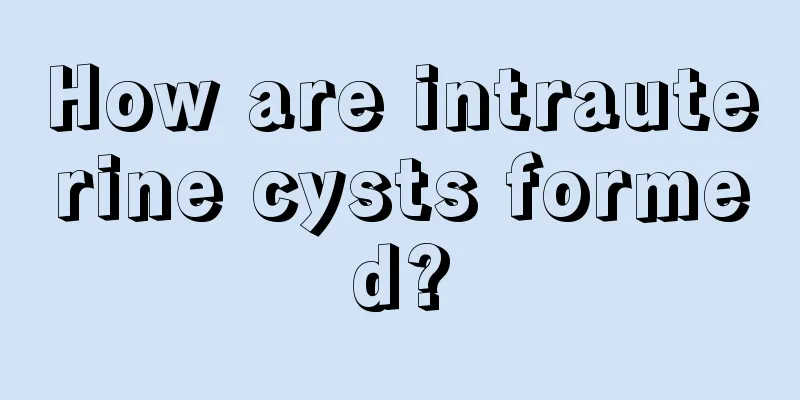How are intrauterine cysts formed?

|
Intrauterine cysts generally refer to uterine cysts. For women, the appearance of cysts in such an important part of the uterus is definitely a very worrying thing. As the incidence of uterine cysts continues to increase, we need to have a more comprehensive understanding of the causative factors of this disease so that we can better prevent and respond to it. So, how are intrauterine cysts formed? Let’s take a look below. Causes Cervical cyst is a pathological manifestation of chronic cervicitis. During the healing process of cervical erosion, the newly formed squamous epithelium covers the openings of the cervical glandular ducts or extends into the glandular ducts, blocking the openings of the glandular ducts. The hyperplasia of connective tissue or scar formation around the glandular duct compresses the glandular duct, causing it to narrow or even block it. The drainage of glandular secretions is obstructed and retained, forming a cyst called a cervical nabothian cyst. The cysts vary in size, but are generally small and scattered. It can appear alone or in multiples. In chronic cervicitis, the cervical glands and surrounding tissues proliferate. When the gland duct is squeezed by the surrounding tissue and the gland opening is blocked, the secretions in the gland cannot flow out and are retained inside, causing the gland cavity to expand and form cystic tumors of varying sizes, called "cervical gland retention cysts", also known as Nabot cysts. Clinical manifestations Cervical cyst is a type of chronic cervicitis, which generally has no obvious symptoms. The main symptom of chronic cervicitis is increased vaginal discharge. Due to different pathogens, the color and amount of vaginal discharge are also different. Leucorrhea may be mucous or purulent, sometimes with streaks of blood or a small amount of blood, and may also cause contact bleeding. Pain often occurs in the lower abdomen or lumbosacral area, and pelvic pain or dysmenorrhea may occur, which is often aggravated during menstruation, bowel movements or sexual intercourse. In addition, irregular menstruation and infertility may occur. examine Cervical cysts vary in size, but are generally small and scattered. It can appear alone or in multiples. It can occur in any part of the cervix. Because during gynecological examinations, a speculum can only detect cysts located at the external os of the cervix. B-ultrasound examination: B-ultrasound can show cysts in various parts of the cervix, and its cyst detection rate can be as high as 100%. Therefore, B-ultrasound examination improves the clinical diagnosis rate and also provides convenience for clinical treatment. diagnosis In addition to clinical manifestations, physical signs and B-ultrasound examination results, pathological histological examination is the basis for diagnosis. treat The main thing is to have a cervical smear test every year to rule out cervical cancer and precancerous diseases. 1. Scattered, smaller cervical cysts generally do not require treatment, and annual checks are sufficient. 2. For densely packed smaller Nabothian cysts or relatively large cysts, phototherapy, laser, microwave, and other physical treatments may be considered. |
>>: Private area melanin deposition
Recommend
There are more reasons to drink cold drinks and eat ice cream! It really doesn't hurt your stomach, but these two factors may be the reason for your diarrhea
Sunny day in August It finally looks like summer ...
What is taro? How to store fresh taro
Taro has high nutritional value and is rich in va...
Sudden pain on the side of one breast
In real life, many women ignore breast pain becau...
Analysis of nosocomial infection factors and nursing prevention in primary hospitals
Hospital infection refers to infections acquired ...
If you have gynecological symptoms, this treatment will be effective!
Nowadays, most gynecological diseases are treated...
Girls have tearing pain below
The female lower body is a private part. When the...
What exactly is the epidemic hemorrhagic fever that occurred in Xi'an? How to prevent and treat it?
As the year draws to a close, Xi'an has encou...
The "magic weight loss drug" can actually support an entire country. Do you know what the success rate of weight loss is?
The magic weight loss drug supports a country: in...
How to judge cosmetic allergy? What to do if you are allergic to cosmetics on your face?
It is everyone's nature to love beauty, espec...
The benefits of taking folic acid every day for women
Folic acid tablets are a water-soluble B vitamin ...
Positive bacteria infection
Many pregnant women may experience positive bacte...
What raw materials are used to produce industrial alcohol? How to distinguish industrial alcohol from medical alcohol
Industrial alcohol refers to alcohol used in indu...
What should you not eat if you have uterine fibroids?
Nowadays, the incidence of uterine fibroids is sh...
What is the reason for yellow-green vaginal discharge with odor?
When a girl becomes a woman, she will be accompan...









